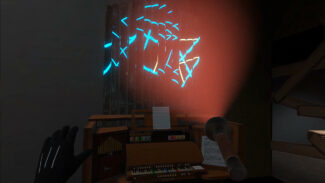VR escape rooms are a dime a dozen; can The Atlas Mystery separate itself from the pack? Read on for our The Atlas Mystery review.
The concept of the real-life escape room has exploded in popularity in recent years, with numerous places in many cities across the world offering various experiences ranging in theme from spy drama to high fantasy. VR developers were quick to pick up on the idea, realizing that an interactive mystery works extremely well in the new medium. Developer Top Right Corner has opted for some 1940s flavor in a spooky theatre in The Atlas Mystery in a way that skirts the edges of the horror genre by combining it with a murder mystery and ghost story.
As the game opens, the player takes the role of a cinema manager who has been tasked with preparing the legendary Atlas Theatre for re-opening. The game is ostensibly set in 1951, but since the cinema has been closed and abandoned since the 1940s, and it uses the classic Art Deco aesthetic of that decade to good effect.
The Atlas Mystery doesn’t veer far from the typical escape room structure; the player moves from room to room in order to solve various puzzles and gather the story threads, which are usually presented in the form of letters and newspaper clippings which tell the story of former Atlas Theatre owner, a Hollywood legend named Oliver Westin. His death led to the initial closing of the theatre. The story is interesting, but poorly integrated with the rest of the game, and sadly proves to be ultimately somewhat unsatisfactory at the ending, even if the player has managed to put together all the scattered story fragments.
The puzzles themselves require careful examination of the environment in order to decipher what to do, but the puzzles themselves vary wildly in challenge, and sometimes need some unlikely leaps of logic to solve. There is no consistent difficulty curve; puzzle types range from turning keys or dials to memorizing and inputting a proper sequence of words or numbers. The most effective puzzles are those which draw strongly on the setting, or delve into the early history of cinema. One of the most pleasing examples involves having to cut together a short length of film and project it on a wall, which is very satisfying and suits the game perfectly.
Only objects that are useful for puzzles or advancing the story are available for interaction, which spoils the immersion somewhat. The interaction itself is somewhat unpolished; sometimes interactive objects will fail to respond properly, and objects often don’t have the proper weight or physics reactions attached to them, which is another immersion-breaking factor. Even something as simple as picking up a letter to read can involve you holding your hand at an awkward angle in order to read it.
Several puzzles involve carrying items between rooms, for which a convenient backpack is provided, though it’s easy to get into the adventure game mindset and carry things with you that you never need to use again. Movement comes in smooth locomotion or teleport, but the smooth locomotion speed is extremely slow, and can prove frustrating for those who don’t deal well with simulation sickness.
Where the game really excels is in its atmosphere. The design of the cinema itself combined with the lighting choices lends itself to a feeling of isolation, and you might find yourself feeling that something is lurking in those deep shadows. The music also strongly contributes, using a 40s/50s sound palette, mostly using a melancholy piano that only adds to the spooky feeling throughout the game.
Despite leaning on the horror atmosphere, there are no jump-scares or scenes of bloody carnage, just a feeling of something watching, which is arguably even more unsettling. That said, even the horror-averse should be fine playing this game, as it never gets more intense than a ‘slightly spooky feeling’
The Atlas Mystery is somewhat short, and can be completed within only 3-4 hours of play, even if you are taking things at a leisurely pace. There is little reason to replay the adventure, unless you have missed some of the story clues. The lack of replayability is somewhat disappointing, as the aesthetic and atmosphere of the cinema could offer a greater scope for exploration and backtracking.
The Atlas Mystery Review – Final Impressions
Ultimately, The Atlas Mystery is a good escape room mystery game but could be greatly improved by adding more interactivity and placing greater emphasis on the story. The setting and particularly the excellent soundtrack is worthy of a greater scope, perhaps with added voice acting and more room to explore. The game is a decent way to spend a couple of hours, but only real escape room buffs will get a higher level of appreciation out of it.
UploadVR recently changed its review guidelines, and this is one of our new unlabelled review categories. You can read more about our review guidelines here.
This review was conducted on PC VR. What did you make of our The Atlas Mystery review? Let us know in the comments below!





